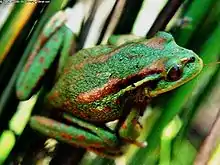Hylorina sylvatica
Hylorina sylvatica (also known as the Emerald forest frog, or in Spanish, sapo arboreo) is a species of frog in the family Batrachylidae.[2] It is monotypic within the genus Hylorina.[3] It is found in Argentina and Chile. This species is endemic to the austral Nothofagus forests of Chile and Argentina with a narrow distribution along the eastern slopes of the Andes.[1][2]
| Hylorina sylvatica | |
|---|---|
 | |
| Scientific classification | |
| Domain: | Eukaryota |
| Kingdom: | Animalia |
| Phylum: | Chordata |
| Class: | Amphibia |
| Order: | Anura |
| Family: | Batrachylidae |
| Genus: | Hylorina Bell, 1843 |
| Species: | H. sylvatica |
| Binomial name | |
| Hylorina sylvatica Bell, 1843 | |
| Synonyms | |
| |
Description
Male Hylorina sylvatica grow to snout-vent length of 53–56 mm (2.1–2.2 in) and females to 60–66 mm (2.4–2.6 in). They are emerald-green during the day while they turn dark green at night.[4] Adults can be found in permanent and temporary pools, swamps, and marshes. Larvae are aquatic and found in pools and ponds.[1]
Conservation status
While Hylorina sylvatica is uncommon and threatened by habitat loss (due to, e.g., logging), IUCN classifies it as of "Least Concern" in view of its wide distribution, presumed large population, and slow rate of decline.[1]
References
- IUCN SSC Amphibian Specialist Group (2019). "Hylorina sylvatica". IUCN Red List of Threatened Species. 2019: e.T57104A79812981. doi:10.2305/IUCN.UK.2019-1.RLTS.T57104A79812981.en. Retrieved 15 November 2021.
- Frost, Darrel R. (2013). "Hylorina sylvatica Bell, 1843". Amphibian Species of the World 5.6, an Online Reference. American Museum of Natural History. Retrieved 6 November 2013.
- Frost, Darrel R. (2013). "Hylorina Bell, 1843". Amphibian Species of the World 5.6, an Online Reference. American Museum of Natural History. Retrieved 6 November 2013.
- "Hylorina sylvatica". AmphibiaWeb: Information on amphibian biology and conservation. [web application]. Berkeley, California: AmphibiaWeb. 2013. Retrieved 6 November 2013.
